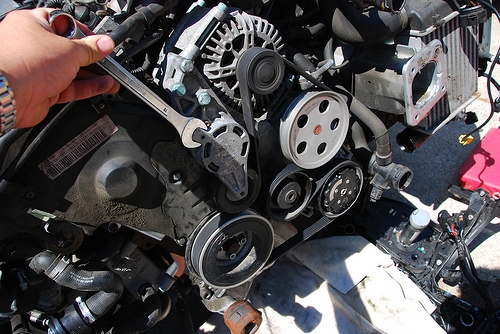
A serpentine belt drive system in an automotive application drives engine accessories such as the alternator, air conditioning compressor, water pump and power brake pump. It will usually be driven off a crankshaft pulley, and unlike earlier multiple belt systems, one continuous belt drives all the accessories.
Check the condition of the entire length of the belt. This procedure will vary depending on make and model. Remove components if necessary and check the vehicle's service manual for the procedure to rotate the crankshaft if necessary. Inspect the belt for missing ribs and fraying.
Procedures for replacement will vary by make and model, but in general begin by noting the path of the old drive belt. If possible take a picture of the front of the engine for reference. There will either be a tensioner pulley or you will need to loosen one of the accessories to release the tension on the belt. Once you release the tension you will be able to remove the belt. Install the new belt in the same position as the old.
Models with a tensioner pulley are self-adjusting. On models without a tensioner pulley you will need to measure the deflection of the belt. Place a straight edge over two of the pulleys with the belt installed. Place a ruler perpendicular to the straight edge halfway between the two pulleys. Press the belt down and measure the distance between the belt and the straight edge. If the span between the two pulleys is less than 12 inches the belt should deflect no more than 1/4 inch. If the span between the two pulleys is greater than 12 inches the belt should deflect no more than 1/2 inch. To tighten the belt locate the engine accessory with the belt adjustment. Use a pry bar to side the accessory outboard then tighten the retaining bolt.